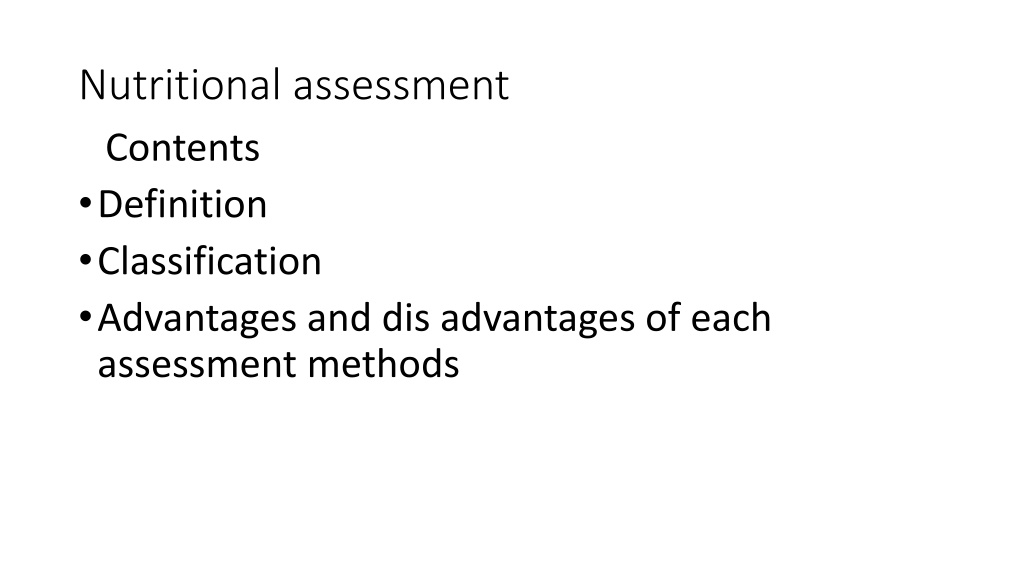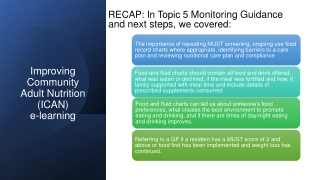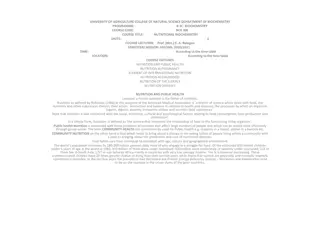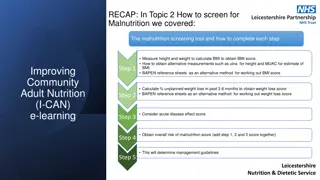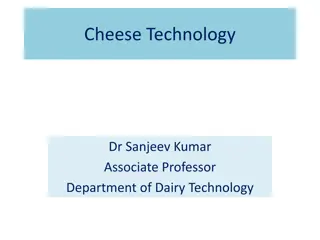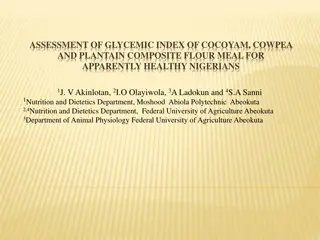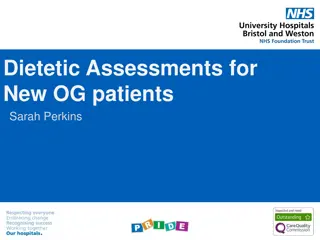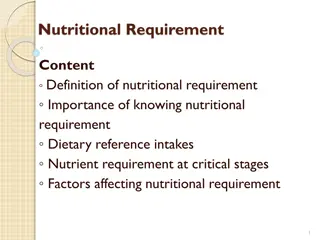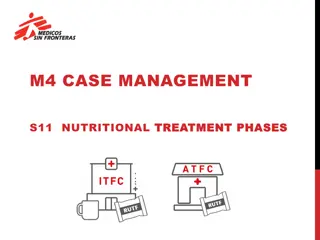Understanding Nutritional Assessment Methods
Nutritional assessment involves evaluating the nutritional status of individuals through various methods such as anthropometry, biophysical assessments, clinical evaluations, and dietary analysis. Anthropometric measurements, such as weight and recumbent length, play a crucial role in assessing growth and body composition. The direct methods of nutritional assessment provide valuable insights into an individual's nutritional adequacy by examining physical dimensions and body composition variations.
Uploaded on Nov 13, 2024 | 0 Views
Download Presentation

Please find below an Image/Link to download the presentation.
The content on the website is provided AS IS for your information and personal use only. It may not be sold, licensed, or shared on other websites without obtaining consent from the author. Download presentation by click this link. If you encounter any issues during the download, it is possible that the publisher has removed the file from their server.
E N D
Presentation Transcript
Nutritional assessment Contents Definition Classification Advantages and dis advantages of each assessment methods
definition Nutritional assessment is the process of nutritional position of an individual or group, at a given point in time, by using proxy measurement of nutritional adequacy. It provides an indication of the adequacy of the balance between dietary intake and metabolic requirement. Can take one of four forms , surveillance, screening or intervention: Surveys Surveillance Screening or Intervention estimating the
Assessment methods Direct methods ANTHROPOMETRY BIOPHYSICAL METHOD CLINICAL METHOD DIETARY METHOD Indirect methods Ecological methods; use population as a whole Functional method; uses the effect of each diet on the body system Vital statics. Uses mortality and morbidity figure to asses nutritional status
We will see only the direct methods Anthropometric Method of Nutritional assessment Measurement of the variations of the physical dimensions and the gross composition of the human body at different age levels and degrees of nutrition Used for assessment of growth in developing countries Anthropometric assessment is done for two purposes Anthropometric measurements of growth Anthropometric measurements of body composition Measurement of fat Measurement of fat-free mass
Weight Weight can be measured with a : Hanging spring scale (< 2 years children) Beam balance (> 2 years) Portable electronic scale Calibration needed after every measurement Remove or make allowance for clothing Wait until the subject calm or remove the cause of anxiety
Recumbent length Measured in children: Younger than 24 months Fewer than 85cm long if age is not known Who are too ill to stand Correct measurement of length requires that: Child is relaxed with no shoes on Child lies parallel to the long axis of the board Crown of the head is against the fixed board Movable board is brought up against the heels
Standing height Measured in children Over 24 months of age 85-110 cm tall if age is not known To measure height, the: The child stands barefoot wearing little clothing Child faces forward with legs straight Head, shoulder blades ,buttocks and heels contact the vertical board Movable headboard is gently lowered Height is recorded to the nearest 0.1cm
Child Height Measurement - Height for Children 24 Months and Older
Head circumference It is an indicator of chronic malnutrition in under two children Not useful for above two children Measuring head circumference: Tape should rest at occipital protuberance and supra-orbital ridge Hair crushed adequately Ears shouldn t be under tape Position should be maintained at the time of reading Head wear should be removed ( as the culture permits) Tape should not be stretchable Measurement recorded to the nearest 1mm
Height-for-age (HFA) Is a measure of stunting Can indicate past malnutrition Is a reasonable predictor of long term mortality Is less useful measure of growth over time than weight-for-age Weight-for-height Weight-for-height (WFH) Is a measure of wasting when low Indicates recent or current malnutrition Is a good predictor of short term mortality Doesn't require that the age of the child is known Requires that two measurements are made
Weight for age Weight-for-age (WFA) Is a composite measure of undernutrition when low Fails to distinguish between wasting and stunting Is a good predictor of long term mortality Is the preferred measure of growth over time unliklly stunting. Head circumference for age An index of chronic malnutrition for under two children due to: IUGR /LBW Malnutrition during first few months of life
Body mass index ( BMI) Described by weight in kg divided by height in meter square Commonly used weight for height ratio Well correlated with adiposity of in most younger and older adults ( sometimes excessive BMI could be from adiposity, muscularity, or edema) Gives no indication about the distribution of the body fat Misclassification is common Lean individuals Very short individuals ( <150cm) or very muscular Abnormal relationship between leg and trunk length ( e.g. Australian Aboriginals) ratio of sitting height to standing height can be used
Classification of over weight ,obesity and CED in adults ( WHO, 2000) Body mass index <16 Grade Grade III CED 16.0-16.9 Grade II CED 17.0-18.5 Underweight (grade I, CED ) 18.5-24.9 Normal 25.00-29.99 Overweight ( pre-obese) 30-34.9 Class I obese 35-39.9 Class II obese >40 Class III severe obesity
Anthropometric assessment of body composition It is based on a model in which the body consists of two chemically distinct compartments Fat and Fat free mass ( skeletal muscle , non-skeletal muscle, and soft lean tissue and the skeleton) Assessment of body fat It is the most variable component of the body which varies with age ,sex and weight Measured by: Skin fold thickness Waist-to-hip circumference ratio
Skin fold thickness Provides an estimate of the size of subcutaneous fat depot Assumptions: Thickness to the subcutaneous adipose tissue reflects a constant proportion of the total body fat The selected skin fold sites are representative Selected sites : Biceps and Triceps ( mid point of the arm), Sub-scapular ( left arm and shoulder relaxed ) Supra-iliac ( above iliac crest at mid axillary line and Mid axillary ( on the Axillary line at the level of xyphoid process ) Best measured by precision skin fold thickness calipers
Waist to hip circumference ratio Measured midway between the lowest rib cage and the anterior superior iliac spine divided by the circumference of the hip measured at the level of the greater trochanter of the femur ( widest point at the buttock) Used to distinguish lower trunk ( hip and buttocks) and fatness in upper trunk (waist and abdomen) Overnight fasting is needed If the ratio is > 1 in male and >0.85 in female there is high risk of cardiovascular complication and related deaths
Mid upper arm circumference (MUAC) MUAC in children is measured between ages 12 and 59 months with a tape. It is important that: MUAC is measured on the midpoint of the left arm The arm hangs freely alongside the body The tape is flat around the skin
MUAC in children aged 12-59 months Wasting overestimated in younger children and underestimated in older ones Is a measure of wasting when low Is a very good predictor of short term mortality Requires a single quick measurement with simple equipment Has relatively large observer variability ( within and between)
Pros and cons of anthropometric measurement Pros Cons Quick Cheaper Give gradable results More accepted by the community Not invasive Can be accurate and precise provides that standardized methods are used Can be used in evaluation of changes in nutritional status Used in screening tests Difficult in selecting appropriate cut- off point Limited diagnostic relevance ( only for type II nutrients) Considerable potential for inaccuracy Need for reasonably precise age in children
CLINICAL METHOD Changes in the superficial tissues or in organs near the surface of the body, which are readily seen or felt upon examination. These include changes in: Eyes Skin Hair or Thyroid gland
Common indicators Edema Dyes-pigmentation of the hair Angular Stomatitis Corneal lesions Swelling (enlargement) of glands Xerosis, etc.
ADVANTAGES Fast & Easy to perform Inexpensive Non-invasive Limitation: Specificity is low; many of the signs are associated with a number of nutritional disorders as well as non-nutritional disorders. Sensitivity is low; sign may appear in the recovery as well as the deficiency state
Are used to determine the amount of nutrients ( proteins, amino acids, Fe, Vitamin ), in cellular components influenced by nutrients ( hemoglobin ,enzymes) , or metabolites ( pyruvate , xanthuric acid), in tissues ( organs muscles ) and body fluids ( blood ,urine) Detects sub clinical deficiency states
Advantages and dis advantages ADVANTAGES Detects sub clinical deficiency states limitation tests can be complex requires expensive equipment needs highly trained staff. Involves invasive procedure
Dietary method of nutritional assessment Contents Level of assessment Classification of dietary methods Limitation and dis advantages
Measuring food consumption at the national level Food balance sheet Provides a comprehensive picture of patterns of country s food supply during specified reference period, calculated from the annual production of food, changes in stokes, imports , exports, and distribution of food over various uses within the country. Total diet studies Studies specifically designed to establish by chemical analysis the dietary intake of food contaminants by a person consuming a typical diet Food are collected from different places and prepared table ready, homogenized and analysed in central laboratories
Measuring food consumption at the household level Food account method- daily record of all food entering the household, either purchased , received as gifts, or produced for HH use during the specified period ( e.g 7ds) Household food record method- emphasizes the food actually consumed by the household members rather than purchased or obtained
Measuring food consumption of individuals two assessment methods Quantitative daily consumption methods ( current intake) Consists of recalls or records designed to measure the quantity of the individual food consumed over a 1-day period. Dietary history and food frequency questionnaire used to obtain retrospective information on the patterns of food use during a longer , less precisely defined time period
24 hour recall method Subjects are asked to remember whatever they consumed within the last 24 hours. This includes all beverages, snacks, dessert, etc This is not sufficient to describe an individual s usual intake of food and nutrients Multiple single day recalls increase the validity Use of standardized protocol Pretesting before wider application
Advantage: Relatively cheap Quick Less respondent burden No chance for the respondents to change their dietary habit Disadvantages It doesn t indicate the usual intake unless conducts for representative days for a particular nutrient intake Respondent memory laps Social desirability bias ( the flat slop syndrome ) Has less precision Accuracy depends on the respondents ability to estimate the portion sizes
Estimated food records The respondent is asked to record , at the time of consumption all food and beverages ( including snakes) eaten in household measures for a specified period of time Standard household measures should be used Number of days included depends on the objective ( average intake or usual intake) The approach varies with the objective to be met Weekends should be proportionately included
Con Advantages Less respondent burden Cheaper than WRM Less time is used Disadvantages Estimation of portion size Social desirability biase
Weighed record method The most precise method available for measuring usual food and nutrient intake of individuals In weighed record method the subject, parent, or caretaker is instructed to weigh all foods and beverages consumed during the time period For mixed dishes the weight of the ingredients ( raw and after cooking) should be measured Amount of food taken outside home recorded ( measure with duplicate bought from the restaurant)
Advantages: It is more accurate ( high reproducibility) There is no respondent memory loss Disadvantage High respondent burden Change of the dietary habit during survey due to fear of burden ( fear of burden or impressing the investigator) Needs literate and numerate respondents Costly
Dietary history Assess the nutrient intake over a longer period of time,( often a month) usually to see the association between diet and disease Conducted by trained interviewer Has three components Interview on the overall pattern of eating ( e.g. what do you usually eat for breakfast?) Frequency of consumption of specific food item Subjects record their intake for three days
Advantage Indicate dietary habit of an individual or group of people It can be applied to a specific dietary habit or intake of specific nutrient of interest ( alcohol intake, fat intake ) Less respondent burden Disadvantage Overemphasizes the regularity of the dietary pattern Very difficult to validate Need highly trained interviewer
Food frequency questionnaire Uses comprehensive list of specific food items to record intakes over a given period. Record can be obtained by interview or self administered questionnaire. ( computerized in the west currently) Should feature simple, well-defined foods and food categories Open-ended questions should be avoided
Advantage Useful to rank individuals broad categories of low , medium and high intake of specific food Identify food patterns associated with inadequate intake of specific nutrient Rapid with low respondent burden Disadvantage Difficult to develop FFQ in multi-cultural society where different staple foods are consumed It needs literate and numerate subjects
Thanks all of you
